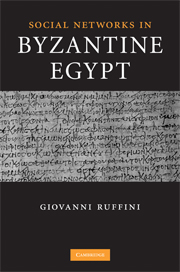Book contents
- Frontmatter
- Contents
- Dedication
- List of figures
- List of tables
- Acknowledgements
- References and abbreviations
- Introduction
- Chapter 1 The centralized elite of Oxyrhynchos
- Chapter 2 The growth of the Apions
- Chapter 3 Aphrodito and the strong ties of village society
- Chapter 4 Quantifying Aphrodito's social network
- Conclusion
- Stemmata
- Bibliography
- Subject index
- Index locorum
Chapter 1 - The centralized elite of Oxyrhynchos
Published online by Cambridge University Press: 26 June 2009
- Frontmatter
- Contents
- Dedication
- List of figures
- List of tables
- Acknowledgements
- References and abbreviations
- Introduction
- Chapter 1 The centralized elite of Oxyrhynchos
- Chapter 2 The growth of the Apions
- Chapter 3 Aphrodito and the strong ties of village society
- Chapter 4 Quantifying Aphrodito's social network
- Conclusion
- Stemmata
- Bibliography
- Subject index
- Index locorum
Summary
INTRODUCTION
As they appear in the surviving evidence, the Oxyrhynchite nome's social networks in the Byzantine period were highly centralized and hierarchical. The chains of social connectivity were generally vertical in nature, formed by unequal social transactions. This chapter's prosopographical study of the Oxyrhynchite elite uncovers a curious phenomenon. We can rarely prove direct links between members of the Oxyrhynchite elite; however, we can often demonstrate indirect links, in which the local office-holders and landowners hired the same scribes, had contact with the same church officials, and so forth. In network terms, the consequences of this sort of connectivity are clear: rather than documenting a web of mingled horizontal and vertical ties similar to what we see in Aphrodito in Chapters 3 and 4, our Oxyrhynchite evidence maps a series of social hubs, in which the landholders are the social centers, and their service personnel are the spokes of the wheel, extending the landholders' social reach throughout the nome. This pattern holds true not only for the elite families who spanned the mid-fifth to the mid-sixth centuries ad, but also for a number of high-profile examples late in the sixth century.
Despite the vast amount of papyrological evidence available, the social history of the Oxyrhynchite nome has long resisted a synthetic book-length treatment. The close prosopographical analysis of the large landholders and other nome elite I provide here fills a small part of that gap.
- Type
- Chapter
- Information
- Social Networks in Byzantine Egypt , pp. 41 - 93Publisher: Cambridge University PressPrint publication year: 2008



